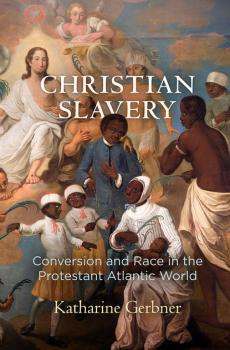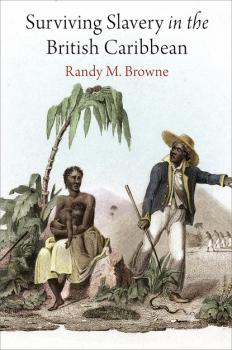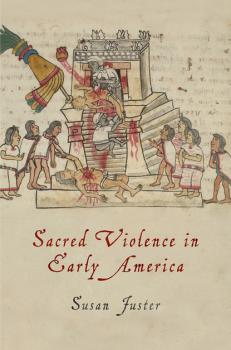Early American Studies
Скачать книги из серии Early American StudiesChristian Slavery
Could slaves become Christian? If so, did their conversion lead to freedom? If not, then how could perpetual enslavement be justified? In Christian Slavery , Katharine Gerbner contends that religion was fundamental to the development of both slavery and race in the Protestant Atlantic world. Slave owners in the Caribbean and elsewhere established governments and legal codes based on an ideology of «Protestant Supremacy,» which excluded the majority of enslaved men and women from Christian communities. For slaveholders, Christianity was a sign of freedom, and most believed that slaves should not be eligible for conversion. When Protestant missionaries arrived in the plantation colonies intending to convert enslaved Africans to Christianity in the 1670s, they were appalled that most slave owners rejected the prospect of slave conversion. Slaveholders regularly attacked missionaries, both verbally and physically, and blamed the evangelizing newcomers for slave rebellions. In response, Quaker, Anglican, and Moravian missionaries articulated a vision of «Christian Slavery,» arguing that Christianity would make slaves hardworking and loyal. Over time, missionaries increasingly used the language of race to support their arguments for slave conversion. Enslaved Christians, meanwhile, developed an alternate vision of Protestantism that linked religious conversion to literacy and freedom. Christian Slavery shows how the contentions between slave owners, enslaved people, and missionaries transformed the practice of Protestantism and the language of race in the early modern Atlantic world.
Warner Mifflin
Warner Mifflin—energetic, uncompromising, and reviled—was the key figure connecting the abolitionist movements before and after the American Revolution. A descendant of one of the pioneering families of William Penn's «Holy Experiment,» Mifflin upheld the Quaker pacifist doctrine, carrying the peace testimony to Generals Howe and Washington across the blood-soaked Germantown battlefield and traveling several thousand miles by horse up and down the Atlantic seaboard to stiffen the spines of the beleaguered Quakers, harried and exiled for their neutrality during the war for independence. Mifflin was also a pioneer of slave reparations, championing the radical idea that after their liberation, Africans in America were entitled to cash payments and land or shared crop arrangements. Preaching «restitution,» Mifflin led the way in making Kent County, Delaware, a center of reparationist doctrine. After the war, Mifflin became the premier legislative lobbyist of his generation, introducing methods of reaching state and national legislators to promote antislavery action. Detesting his repeated exercise of the right of petition and hating his argument that an all-seeing and affronted God would punish Americans for «national sins,» many Southerners believed Mifflin was the most dangerous man in America—"a meddling fanatic" who stirred the embers of sectionalism after the ratification of the Constitution of 1787. Yet he inspired those who believed that the United States had betrayed its founding principles of natural and inalienable rights by allowing the cancer of slavery and the dispossession of Indian lands to continue in the 1790s. Writing in beautiful prose and marshaling fascinating evidence, Gary B. Nash constructs a convincing case that Mifflin belongs in the Quaker antislavery pantheon with William Southeby, Benjamin Lay, John Woolman, and Anthony Benezet.
Surviving Slavery in the British Caribbean
Atlantic slave societies were notorious deathtraps. In Surviving Slavery in the British Caribbean , Randy M. Browne looks past the familiar numbers of life and death and into a human drama in which enslaved Africans and their descendants struggled to survive against their enslavers, their environment, and sometimes one another. Grounded in the nineteenth-century British colony of Berbice, one of the Atlantic world's best-documented slave societies and the last frontier of slavery in the British Caribbean, Browne argues that the central problem for most enslaved people was not how to resist or escape slavery but simply how to stay alive. Guided by the voices of hundreds of enslaved people preserved in an extraordinary set of legal records, Browne reveals a world of Caribbean slavery that is both brutal and breathtakingly intimate. Field laborers invoked abolitionist-inspired legal reforms to protest brutal floggings, spiritual healers conducted secretive nighttime rituals, anxious drivers weighed the competing pressures of managers and the condition of their fellow slaves in the fields, and women fought back against abusive masters and husbands. Browne shows that at the core of enslaved people's complicated relationships with their enslavers and one another was the struggle to live in a world of death. Provocative and unflinching, Surviving Slavery in the British Caribbean reorients the study of Atlantic slavery by revealing how differently enslaved people's social relationships, cultural practices, and political strategies appear when seen in the light of their unrelenting struggle to survive.
The American Revolution Reborn
The American Revolution conjures a series of iconographic images in the contemporary American imagination. In these imagined scenes, defiant Patriots fight against British Redcoats for freedom and democracy, while a unified citizenry rallies behind them and the American cause. But the lived experience of the Revolution was a more complex matter, filled with uncertainty, fear, and discord. In The American Revolution Reborn , editors Patrick Spero and Michael Zuckerman compile essays from a new generation of multidisciplinary scholars that render the American Revolution as a time of intense ambiguity and frightening contingency. The American Revolution Reborn parts company with the Revolution of our popular imagination and diverges from the work done by historians of the era from the past half-century. In the first section, «Civil Wars,» contributors rethink the heroic terms of Revolutionary-era allegiance and refute the idea of patriotic consensus. In the following section, «Wider Horizons,» essayists destabilize the historiographical inevitability of America as a nation. The studies gathered in the third section, «New Directions,» present new possibilities for scholarship on the American Revolution. And the last section, titled «Legacies,» collects essays that deal with the long afterlife of the Revolution and its effects on immigration, geography, and international politics. With an introduction by Spero and a conclusion by Zuckerman, this volume heralds a substantial and revelatory rebirth in the study of the American Revolution. Contributors: Zara Anishanslin, Mark Boonshoft, Denver Brunsman, Katherine Carté Engel, Aaron Spencer Fogleman, Travis Glasson, Edward G. Gray, David C. Hsiung, Ned C. Landsman, Michael A. McDonnell, Kimberly Nath, Bryan Rosenblithe, David S. Shields, Patrick Spero, Matthew Spooner, Aaron Sullivan, Michael Zuckerman.
Dangerous Neighbors
Dangerous Neighbors shows how the Haitian Revolution permeated early American print culture and had a profound impact on the young nation's domestic politics. Focusing on Philadelphia as both a representative and an influential vantage point, it follows contemporary American reactions to the events through which the French colony of Saint Domingue was destroyed and the independent nation of Haiti emerged. Philadelphians made sense of the news from Saint Domingue with local and national political developments in mind and with the French Revolution and British abolition debates ringing in their ears. In witnessing a French colony experience a revolution of African slaves, they made the colony serve as powerful and persuasive evidence in domestic discussions over the meaning of citizenship, equality of rights, and the fate of slavery. Through extensive use of manuscript sources, newspapers, and printed literature, Dun uncovers the wide range of opinion and debate about events in Saint Domingue in the early republic. By focusing on both the meanings Americans gave to those events and the uses they put them to, he reveals a fluid understanding of the American Revolution and the polity it had produced, one in which various groups were making sense of their new nation in relation to both its own past and a revolution unfolding before them. Zeroing in on Philadelphia—a revolutionary center and an enclave of antislavery activity—Dun collapses the supposed geographic and political boundaries that separated the American republic from the West Indies and Europe.
Slavery's Capitalism
During the nineteenth century, the United States entered the ranks of the world's most advanced and dynamic economies. At the same time, the nation sustained an expansive and brutal system of human bondage. This was no mere coincidence. Slavery's Capitalism argues for slavery's centrality to the emergence of American capitalism in the decades between the Revolution and the Civil War. According to editors Sven Beckert and Seth Rockman, the issue is not whether slavery itself was or was not capitalist but, rather, the impossibility of understanding the nation's spectacular pattern of economic development without situating slavery front and center. American capitalism—renowned for its celebration of market competition, private property, and the self-made man—has its origins in an American slavery predicated on the abhorrent notion that human beings could be legally owned and compelled to work under force of violence. Drawing on the expertise of sixteen scholars who are at the forefront of rewriting the history of American economic development, Slavery's Capitalism identifies slavery as the primary force driving key innovations in entrepreneurship, finance, accounting, management, and political economy that are too often attributed to the so-called free market. Approaching the study of slavery as the originating catalyst for the Industrial Revolution and modern capitalism casts new light on American credit markets, practices of offshore investment, and understandings of human capital. Rather than seeing slavery as outside the institutional structures of capitalism, the essayists recover slavery's importance to the American economic past and prompt enduring questions about the relationship of market freedom to human freedom. Contributors : Edward E. Baptist, Sven Beckert, Daina Ramey Berry, Kathryn Boodry, Alfred L. Brophy, Stephen Chambers, Eric Kimball, John Majewski, Bonnie Martin, Seth Rockman, Daniel B. Rood, Caitlin Rosenthal, Joshua D. Rothman, Calvin Schermerhorn, Andrew Shankman, Craig Steven Wilder.
Sacred Violence in Early America
Sacred Violence in Early America offers a sweeping reinterpretation of the violence endemic to seventeenth-century English colonization by reexamining some of the key moments of cultural and religious encounter in North America. Susan Juster explores different forms of sacred violence—blood sacrifice, holy war, malediction, and iconoclasm—to uncover how European traditions of ritual violence developed during the wars of the Reformation were introduced and ultimately transformed in the New World. Juster's central argument concerns the rethinking of the relationship between the material and the spiritual worlds that began with the Reformation and reached perhaps its fullest expression on the margins of empire. The Reformation transformed the Christian landscape from an environment rich in sounds, smells, images, and tactile encounters, both divine and human, to an austere space of scriptural contemplation and prayer. When English colonists encountered the gods and rituals of the New World, they were forced to confront the unresolved tensions between the material and spiritual within their own religious practice. Accounts of native cannibalism, for instance, prompted uneasy comparisons with the ongoing debate among Reformers about whether Christ was bodily present in the communion wafer. Sacred Violence in Early America reveals the Old World antecedents of the burning of native bodies and texts during the seventeenth-century wars of extermination, the prosecution of heretics and blasphemers in colonial courts, and the destruction of chapels and mission towns up and down the North American seaboard. At the heart of the book is an analysis of «theologies of violence» that gave conceptual and emotional shape to English colonists' efforts to construct a New World sanctuary in the face of enemies both familiar and strange: blood sacrifice, sacramentalism, legal and philosophical notions of just and holy war, malediction, the contest between «living» and «dead» images in Christian idology, and iconoclasm.
The Haitian Revolution and the Early United States
When Jean-Jacques Dessalines proclaimed Haitian independence on January 1, 1804, Haiti became the second independent republic, after the United States, in the Americas; the Haitian Revolution was the first successful antislavery and anticolonial revolution in the western hemisphere. The histories of Haiti and the early United States were intimately linked in terms of politics, economics, and geography, but unlike Haiti, the United States would remain a slaveholding republic until 1865. While the Haitian Revolution was a beacon for African Americans and abolitionists in the United States, it was a terrifying specter for proslavery forces there, and its effects were profound. In the wake of Haiti's liberation, the United States saw reconfigurations of its geography, literature, politics, and racial and economic structures. The Haitian Revolution and the Early United States explores the relationship between the dramatic events of the Haitian Revolution and the development of the early United States. The first section, «Histories,» addresses understandings of the Haitian Revolution in the developing public sphere of the early United States, from theories of state sovereignty to events in the street; from the economic interests of U.S. merchants to disputes in the chambers of diplomats; and from the flow of rumor and second-hand news of refugees to the informal communication networks of the enslaved. The second section, «Geographies,» explores the seismic shifts in the ways the physical territories of the two nations and the connections between them were imagined, described, inhabited, and policed as a result of the revolution. The final section, «Textualities,» explores the wide-ranging consequences that reading and writing about slavery, rebellion, emancipation, and Haiti in particular had on literary culture in both the United States and Haiti. With essays from leading and emerging scholars of Haitian and U.S. history, literature, and cultural studies, The Haitian Revolution and the Early United States traces the rich terrain of Haitian-U.S. culture and history in the long nineteenth century. Contributors: Anthony Bogues, Marlene Daut, Elizabeth Maddock Dillon, Michael Drexler, Laurent Dubois, James Alexander Dun, Duncan Faherty, Carolyn Fick, David Geggus, Kieran Murphy, Colleen O'Brien, Peter P. Reed, Siân Silyn Roberts, Cristobal Silva, Ed White, Ivy Wilson, Gretchen Woertendyke, Edlie Wong.
Professional Indian
Born in 1788, Eleazer Williams was raised in the Catholic Iroquois settlement of Kahnawake along the St. Lawrence River. According to some sources, he was the descendant of a Puritan minister whose daughter was taken by French and Mohawk raiders; in other tales he was the Lost Dauphin, second son to Louis XVI of France. Williams achieved regional renown as a missionary to the Oneida Indians in central New York; he was also instrumental in their removal, allying with white federal officials and the Ogden Land Company to persuade Oneidas to relocate to Wisconsin. Williams accompanied them himself, making plans to minister to the transplanted Oneidas, but he left the community and his young family for long stretches of time. A fabulist and sometime confidence man, Eleazer Williams is notoriously difficult to comprehend: his own record is complicated with stories he created for different audiences. But for author Michael Leroy Oberg, he is an icon of the self-fashioning and protean identity practiced by native peoples who lived or worked close to the centers of Anglo-American power. Professional Indian follows Eleazer Williams on this odyssey across the early American republic and through the shifting spheres of the Iroquois in an era of dispossession. Oberg describes Williams as a «professional Indian,» who cultivated many political interests and personas in order to survive during a time of shrinking options for native peoples. He was not alone: as Oberg shows, many Indians became missionaries and settlers and played a vital role in westward expansion. Through the larger-than-life biography of Eleazer Williams, Professional Indian uncovers how Indians fought for place and agency in a world that was rapidly trying to erase them.
Capitalism by Gaslight
While elite merchants, financiers, shopkeepers, and customers were the most visible producers, consumers, and distributors of goods and capital in the nineteenth century, they were certainly not alone in shaping the economy. Lurking in the shadows of capitalism's past are those who made markets by navigating a range of new financial instruments, information systems, and modes of transactions: prostitutes, dealers in used goods, mock auctioneers, illegal slavers, traffickers in stolen horses, emigrant runners, pilfering dock workers, and other ordinary people who, through their transactions and lives, helped to make capitalism as much as it made them. Capitalism by Gaslight illuminates American economic history by emphasizing the significance of these markets and the cultural debates they provoked. These essays reveal that the rules of economic engagement were still being established in the nineteenth century: delineations between legal and illegal, moral and immoral, acceptable and unsuitable were far from clear. The contributors examine the fluid mobility and unstable value of people and goods, the shifting geographies and structures of commercial institutions, the blurred boundaries between legitimate and illegitimate economic activity, and the daily lives of men and women who participated creatively—and often subversively—in American commerce. With subjects ranging from women's studies and African American history to material and consumer culture, this compelling volume illustrates that when hidden forms of commerce are brought to light, they can become flashpoints revealing the tensions, fissures, and inequities inherent in capitalism itself. Contributors: Paul Erickson, Robert J. Gamble, Ellen Gruber Garvey, Corey Goettsch, Joshua R. Greenberg, Katie M. Hemphill, Craig B. Hollander, Brian P. Luskey, Will B. Mackintosh, Adam Mendelsohn, Brendan P. O'Malley, Michael D. Thompson, Wendy A. Woloson.









